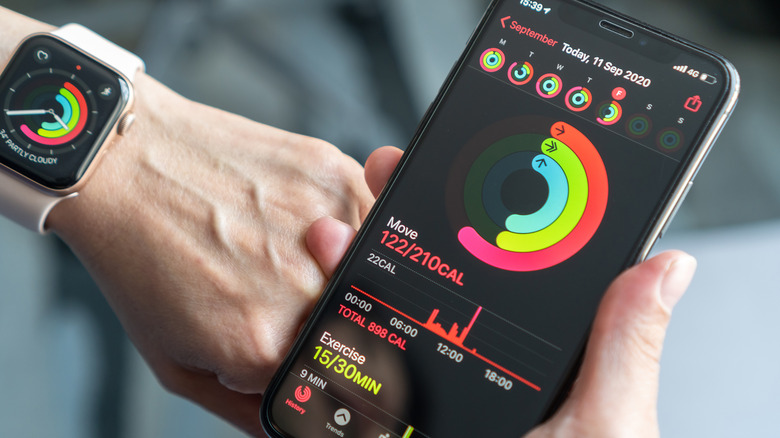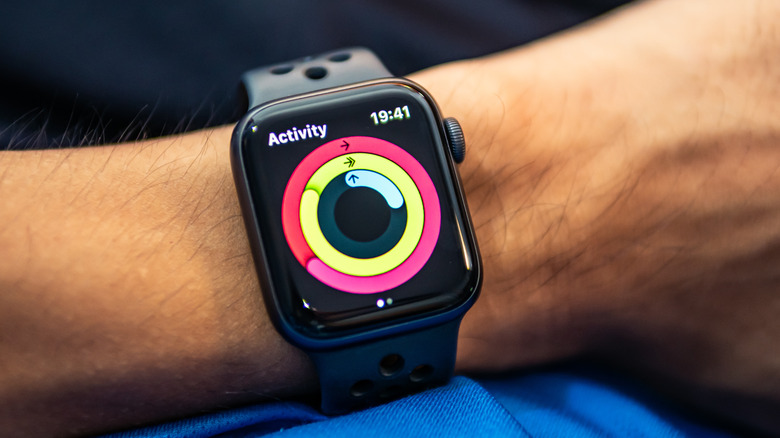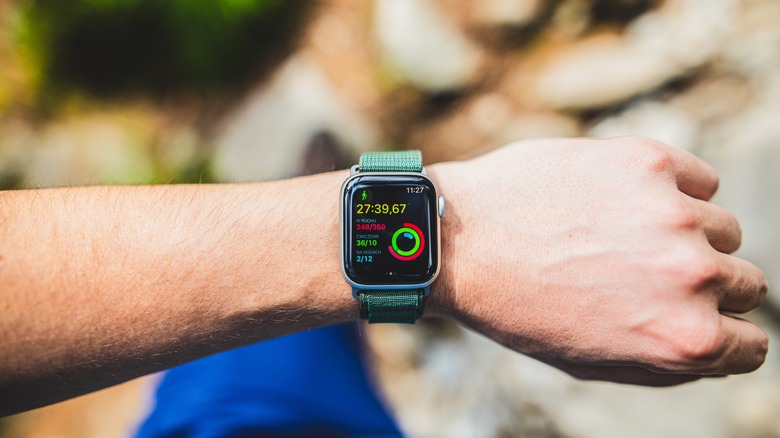What Should Your Apple Watch Move Goal Be? 4 Factors To Consider
When it comes to wearable technology, the Apple Watch has crafted a unique niche for itself, especially with how seamlessly it works with the rest of the Apple ecosystem. Although it has a lot of interesting features like tap to cash, family check-in, and translation, many people use it for the primary purpose of being a companion in their fitness journey.
With your Apple Watch, you can use the Apple Fitness app to keep track of three key goals: Move, Exercise, and Stand. While these have different metrics, all of them are designed to encourage you to be on your feet and get moving. Between the three, the largest "ring" (and arguably the hardest one to complete) is the Move ring.
To "close the ring" and hit the Move goal, you'll need to burn your target number of active calories. Unlike passive calories, which you burn when you're resting, active calories are measured by the amount of physical movement that combines the calories burned from exercise plus non-exercise activity thermogenesis (NEAT) or movement that we do in our day-to-day life.
In its research, Gitnux shares that Apple's average recommended Move goal ranges from 150 calories to 400 calories, depending on the age of the user. To get the estimated Move goal for you, you'll need to fill out the personal information section on the Fitness app. But is the standard number of calories really the right number for you? Here's how to know and what other factors you should consider.
Your body's baseline fitness level
When it comes to starting any fitness journey, knowing your body and what it can do is the first step. While this can seem like an easy concept to grasp, the reality is that you could be overestimating or underestimating your current fitness level. Without setting a proper baseline, you put yourself at risk of unreasonable expectations, which can lead to inconsistency. Some factors that generally affect your body's ability to burn calories include your age, gender, and body composition. To get a rough estimate on where your body is at, you can test it yourself and find your daily average calories burned for a week or visit a clinic or gym with machines that can reveal your body composition, basal metabolic rate (BMR), or resting energy expenditure (REE).
It's important to note that your body's on-paper, chronological age isn't always the same as your body's metabolic age. For example, a healthy and active 30-year-old may have a younger metabolic age than someone who is 25 years old but eats a poor diet and lives a sedentary lifestyle. That said, Apple takes age into consideration when it comes to recommended Move goals, such as showing minutes spent being active instead of calories burned for children aged 13 and below. This is useful because developing bodies will have different movement needs from adult bodies and it encourages a healthy relationship with movement that puts less emphasis on calorie counting.
Identify your specific fitness goals
After you get a clearer picture of your starting point, you can craft a realistic fitness plan based on your particular goals. Each person will have a different view of what being "fit" looks and feels like, so being clear with your intentions is the best way to craft the ideal movement plan and how it is distributed throughout the week. Typically, many people looking to be healthier either want to lose weight, gain muscle, or maintain their current body. However, your fitness goals can also be staying consistent with your steps or learning new ways to move your body. Depending on your specific fitness goal, your Move goal will need to adjust to accommodate it.
While some people struggle with metabolic issues that can prevent them from losing weight, most people tend to lose weight when they use more calories than they consume. So, if your goal is weight loss, you should take into account both your current BMR and Move goal target, so they are over the calories you get from food or drinks to create a deficit. That said, it's important to note that while your Apple Watch is a great way to track your weight loss journey, it's only meant as a companion and doesn't take the place of professional consultation or advice. Speaking with a health professional or coach can help you determine the ideal calorie deficit range to reach your goals within a set time frame (safely).
Existing medical conditions
When it comes to the Fitness app goal recommendations, they formed under the assumption that you are an average person within your age group. However, factors like chronic health conditions, medical history, and injuries can mean you don't necessarily fit the same box as everyone else. Because of this, your ideal Move goal will likely not match the one designed for everyone else.
Depending on your condition, this might mean having a significantly lower Move goal to accommodate enough recovery time and engaging in less intense forms of movement. For example, instead of doing high impact activities like HIIT, you may want to do gentler exercises like yoga, until an injury fully heals. Alternatively, you can also increase the frequency of your low intensity exercises, like walking every day, instead of lifting heavy weights three times a week. With this, you can have a lower daily Move goal, but burn the same amount of calories spread out consistently throughout the week.
Aside from features that help you stay in shape, the Apple Watch also comes with features that can help warn you if something is off with your body during a workout. For example, you can use the Apple Watch to track your heart rate, blood oxygen levels, and even notify others if you fall. While you're at it, don't forget to take note of the different things you can do to improve your Apple Watch measurements, like making sure it fits correctly and using the right settings.
Understand the impact of your lifestyle
In an ideal world, we all live in walkable cities, have time to work out, and can afford gym memberships. However, this isn't always the case, which makes hitting Move goals an uphill battle for many people whose lifestyles are a little more sedentary in nature. After all, while the Apple Watch can remind you to move around, you may have limited space to move in your home, have to stay in close proximity to your children, or work a strict desk job. Because of this, there's no shame in setting a Move goal that is a little less intimidating. While your Move goals should be a little challenging, they shouldn't be a source of shame if you don't hit them or be so difficult that you feel extremely overwhelmed.
Although some people have available energy to dedicate to changing their fitness habits overnight, others need a little more time to adjust, especially if their environment is not conducive to movement. If this strikes a chord with you, you should aim to slowly integrate Move goals into your life until it becomes a painless part of your everyday routine. Then, you can opt to build momentum slowly and increase your movement goals again when you're more confident or have build better systems to accommodate them.
How to change your Move goals
Once you've decided on the right Move goal for you, you can adjust it via Apple Watch or the iPhone Fitness app. To start with, here's how to do it on your Apple Watch.
-
On your Apple Watch, launch the Activity app.
Advertisement -
Scroll down using your digital crown.
-
Select Change Move Goal.
-
If you want to increase your Move Goal, tap the plus (+) icon. On the other hand, tap the minus (-) icon if you want to commit to less movement.
In the past, the Fitness app's rings, which include the Move goals, were only accessible to Apple Watch owners. However, this all changed with the onset of iOS 16, when regular iPhone users could benefit from it as well. So, if you have an eligible iPhone on-hand, here's how to change your Move goal.
-
On your iPhone, launch the Fitness app.
-
In the upper-right corner of the screen, tap your profile image.
-
Tap Change Move Goal.
-
Select the plus (+) icon to increase your movement goals and the minus (-) icon to decrease it.
Advertisement -
Tap Change Move Goal to confirm the changes.
When you adjust your Move goal, you'll be able to adjust it by increments of 10 at a time. To check if the change was successful, simply return to your Fitness app homepage and check the number under Activity. Alternatively, you can also check your Apple Watch if the new goal has been implemented.
Create a holistic fit life with your Apple Watch
Since Apple Watch calorie counts are not entirely accurate, you don't have to beat yourself up if you don't meet your Move goals everyday. As long as you're seeing a consistent, positive trend, there's something to celebrate. After all, life is a marathon and not a race. While your Apple Watch may recommend new goal numbers based on your previous usage, it's still up to you to decide if you are ready to challenge yourself with a higher number or want to allow yourself some grace after a particularly tough week.
Remember, your Move goals are between you and your Apple Watch, and there's no need to impress anyone else. At the end of the day, learning to enjoy movement and finding the most enjoyable forms of it is more important than simply hitting an arbitrary goal on your Apple Watch's screen.
That said, it's important to know that when it comes to a healthy lifestyle, movement is only half the equation. To be fit in a holistic way, you'll also want to be mindful of your nutrition, water intake, and mental health. Thankfully, there are plenty of Apple Watch apps that can help you become healthier, such as helping you stick to your diet, drink more water, and manage stress.






